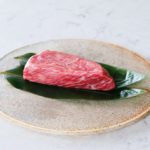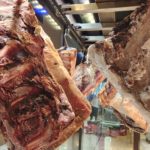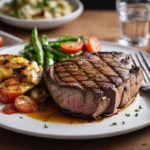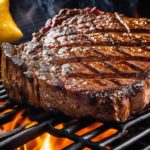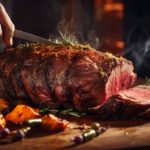Do you ever find yourself standing at the butcher counter, torn between a rib steak and a bone-in ribeye? I know that feeling all too well. Having spent countless hours researching and experimenting with these two mouth-watering beef cuts, I’ve amassed an ocean of knowledge on their unique flavor profiles.
In this article, we’ll delve deep into each cut’s characteristics from marbling to cooking techniques to help you make an informed decision for your next barbecue. Ready for some juicy details?.
Key Takeaways
- Rib steaks and bone – in ribeyes are both delicious cuts of beef with unique flavor profiles. They have the right amount of marbling which adds to their rich taste.
- Rib steaks are known for their tenderness and rich flavor due to the perfect balance of fat and meat. The marbling keeps them moist while cooking.
- Bone – in ribeyes also have intense beef flavor and tenderness, thanks to the marbling throughout the meat. The bone adds extra flavor.
- When cooking these steaks, grilling or broiling are great methods for rib steaks, while grilling or pan-searing work well for bone-in ribeyes. Experiment with different seasonings and accompaniments to enhance their natural flavors.
Understanding the Flavor Profiles of Rib Steaks and Bone-In Ribeyes
Rib steaks and bone-in ribeyes are both amazing in their own ways. These cuts of beef have the right amount of fat which makes them so tasty. Rib steak has a rich flavor. This is because it has lots of fat mixed with meat or “marbling.” Fat equals taste!
The bone-in ribeye also tastes great for the same reason – marbling! Some might even say that the bone adds to its flavor. Topped with some salt, oregano, and garlic powder, this steak becomes deliciously mouth-watering.
There’s no clear winner between these two in terms of taste though. Their unique flavors make them both top choices for meat lovers like us! One thing’s sure – they’re both super flavorful and would surely satisfy your craving for a good piece of well-marbled beef!
Differences in Cut and Marbling
Rib steaks are cut from the rib section of the cow, known for its tenderness and rich marbling, while bone-in ribeyes are also cut from the rib section but with a bone attached, providing added flavor.
Rib Steaks: Location, fat content, and marbling
Rib steaks are cut from the rib section of the beef, which is near the back of the cow. They have just the right amount of fat that adds flavor and juiciness to the meat. The marbling in rib steaks refers to those thin lines of fat that you see running through the meat.
This marbling helps to keep the steak tender and moist while cooking. Rib steaks are known for their rich flavor profile, as they have a good balance of fat and meat. So when you bite into a rib steak, you can expect a deliciously flavorful experience!
Bone-In Ribeyes: Location, fat content, and marbling
When it comes to bone-in ribeyes, let’s talk about location, fat content, and marbling. The bone-in ribeye is cut from the rib section of the beef. It has a good amount of fat marbling throughout the meat, which adds flavor and juiciness.
This marbling is what gives the steak its rich and robust taste. The fat content in bone-in ribeyes makes them tender and succulent when cooked properly. So if you’re looking for a flavorful steak with that perfect balance of fat and meat, the bone-in ribeye is a great choice!
Cooking Methods and Techniques
The best cooking methods for Rib Steaks include grilling or broiling to enhance the natural flavors of the meat.
https://www.youtube.com/watch?v=u7sQjOFFISw
Best cooking methods for Rib Steaks
When it comes to cooking rib steaks, there are a few methods that really bring out the best flavors. Here are some of the best cooking methods for rib steaks:
- Grilling: This is a classic method for cooking rib steaks and can result in a delicious charred exterior and juicy interior.
- Pan-searing: Heat up a skillet with some oil or butter and sear the rib steak on both sides until it’s browned and cooked to your desired doneness.
- Broiling: Preheat your oven’s broiler and place the rib steak on a rack in a broiler pan. Cook for a few minutes on each side until it’s cooked to your liking.
- Sous vide: If you have a sous vide machine, you can cook the rib steak in a vacuum-sealed bag at a precise temperature for tender and perfectly cooked meat.
- Reverse searing: This method involves slowly cooking the rib steak in the oven at a low temperature and then finishing it off with a quick sear in a hot pan or on the grill.
Best cooking methods for Bone-In Ribeyes
If you’re a meat lover like me, you’ll want to know the best ways to cook bone-in ribeyes. Here are some tried and true cooking methods that will bring out the best flavors in this delicious cut of beef:
- Grilling: The smoky flavor that grilling imparts on a bone-in ribeye is hard to beat. Preheat your grill to medium-high heat and sear the steak for a few minutes on each side. Then move it to indirect heat and continue cooking until it reaches your desired level of doneness.
- Broiling: If you don’t have access to a grill, broiling is a great alternative. Place your bone-in ribeye on a broiler pan and place it about 4-6 inches away from the heat source. Cook for about 4-5 minutes on each side, or until it reaches your preferred level of doneness.
- Pan-searing: Heat up a cast-iron skillet over high heat until it’s smoking hot. Season your bone-in ribeye with salt and pepper, then place it in the skillet. Sear for about 2-3 minutes per side, then reduce the heat slightly and continue cooking until done.
- Sous vide: For the ultimate precision in cooking bone-in ribeyes, try sous vide. Vacuum-seal your steak with any desired seasonings and cook it in a water bath at the recommended temperature (usually around 130°F) for several hours. Finish by quickly searing in a hot pan or on the grill for added flavor.
Flavor and Texture Comparison
When it comes to flavor and texture, both rib steaks and bone-in ribeyes offer a rich, intense beef flavor that meat lovers crave.
Rib Steaks: Intensity of beef flavor, tenderness
Rib steaks are known for their intense beef flavor and tender texture. When you bite into a rib steak, you can expect a rich and hearty taste that will satisfy any meat lover’s cravings.
The marbling in rib steaks adds to the juiciness and tenderness of the meat, making it incredibly flavorful. Whether you grill it or cook it on the stovetop, rib steaks are sure to impress with their bold taste and melt-in-your-mouth goodness.
So if you’re looking for a steak with robust flavor and exceptional tenderness, rib steaks are definitely worth trying!
Bone-In Ribeyes: Intensity of beef flavor, tenderness
Bone-in ribeyes are known for their intense beef flavor and tenderness. The marbling in these steaks adds richness and juiciness, making them incredibly flavorful. When cooked properly, bone-in ribeyes can melt in your mouth with every bite.
The fat content enhances the taste and creates a tender texture that meat lovers adore. Whether you grill or pan-sear bone-in ribeyes, the result is a juicy steak packed with delicious flavors.
Pair it with simple seasonings like salt, oregano, and garlic powder to bring out the natural flavors of the meat even more.
Choosing the Right Steak for Your Preference
Consider factors such as cut, marbling, cooking method, and your personal flavor preference when selecting between a rib steak or bone-in ribeye. Pair your chosen steak with complementary sides and accompaniments to enhance the overall dining experience.
Factors to consider: Cut, marbling, cooking method, flavor preference
When choosing a steak, there are a few factors to consider:
- Cut: Different cuts of steak have different flavor profiles and textures. Rib steaks and bone-in ribeyes are both delicious options, but they have slight differences in taste and tenderness.
- Marbling: The amount of fat marbled throughout the meat can greatly influence the flavor and juiciness of the steak. Rib steaks and bone-in ribeyes are known for their rich marbling, which adds to their incredible taste.
- Cooking method: The way you cook your steak can also impact its final taste. Rib steaks are best cooked quickly over high heat to maintain their tenderness, while bone-in ribeyes benefit from slower cooking methods like grilling or roasting to allow the fat to render and enhance the flavor.
- Flavor preference: Ultimately, your personal taste preferences should guide your choice of steak. Some people prefer the intense beefy flavor of rib steaks, while others enjoy the richness of bone-in ribeyes. Experimenting with different cuts and cooking methods can help you discover your favorite flavors.
Pairing suggestions and accompaniments
When it comes to enjoying rib steaks and bone-in ribeyes, there are some delicious pairing suggestions and accompaniments that can enhance your dining experience. Here are a few ideas:
- Classic side dishes: Serve your steak with traditional sides like mashed potatoes, roasted vegetables, or a crisp salad.
- Red wine: Pair your steak with a bold red wine, such as a Cabernet Sauvignon or Merlot, to complement the rich flavors of the meat.
- Grilled vegetables: Grilling some fresh veggies alongside your steak adds a tasty and nutritious touch to your meal.
- Creamy sauces: Consider topping your steak with a creamy mushroom sauce or peppercorn sauce for an extra burst of flavor.
- Garlic butter: A pat of garlic butter melting on top of your steak can take it to the next level of deliciousness.
- Crusty bread: Don’t forget to serve some warm, crusty bread on the side to soak up all those juicy flavors.
- Seasonings and rubs: Experiment with different seasonings and rubs to enhance the taste of your steak, such as Montreal steak seasoning or a simple salt and pepper rub.
Conclusion
In conclusion, exploring the flavor profiles of rib steaks and bone-in ribeyes can be a delicious adventure for meat lovers. These cuts of beef offer unique tastes and textures, with the perfect amount of marbling to enhance flavor.
Whether you prefer the rich taste of a rib steak or the beefy goodness of a bone-in ribeye, there is no wrong choice when it comes to savoring these mouthwatering steaks. So fire up your grill, season them just right, and enjoy a juicy and flavorful dining experience that will satisfy your cravings every time!
FAQs
1. What is the difference between rib steaks and bone-in ribeyes?
Rib steaks and bone-in ribeyes are cuts of beef that come from the same section of the cow, but a bone-in ribeye contains the rib bone, while a rib steak does not.
2. How should I cook a rib steak to bring out its flavor?
To bring out the flavor of a rib steak, you can grill it over high heat or pan-sear it in a hot skillet with some oil. Season with salt and pepper for extra taste.
3. Are there any specific seasonings or marinades that pair well with bone-in ribeyes?
Bone-in ribeyes have rich flavors on their own, but you can enhance them with simple seasonings like garlic powder, rosemary, or a sprinkle of sea salt. Marinades made from soy sauce, Worcestershire sauce, or balsamic vinegar can also add depth to the flavors.
4. Can I use these cuts for other dishes besides grilling?
Yes! Rib steaks and bone-in ribeyes are versatile cuts that can be used in various dishes such as stir-fries or stews if they’re cut into smaller pieces. However, grilling or searing them allows their natural flavors to shine through best
Greetings!
With over two decades of diverse experience in the meat industry, I proudly stand as an expert in all things meat. My journey commenced with a strong foundation in hospitality, where I honed my culinary skills as a chef in prestigious restaurants and on luxurious superyachts worldwide.
However, my true passion lies in the art of butchery. Throughout my extensive career, I have had the privilege of working with renowned meat purveyors and mastering the craft of meat cutting and preparation. From breaking down whole carcasses to meticulously selecting prime cuts, my butchery expertise is at the core of my meat knowledge.
Having immersed myself in various cultures and cuisines, I have honed my skills to deliver exceptional dining experiences, crafting delectable dishes that celebrate the natural flavors of different meats. Whether it's sourcing the finest meats for discerning clients or sharing valuable tips on meat selection and cooking, I take pride in elevating the meat experience for both professionals and enthusiasts.
My journey has taken me from the bustling kitchens of top-rated restaurants to the heart of meat processing facilities, gaining insights and honing my skills to become a true meat connoisseur. Now, I am enthusiastic about sharing my expertise, offering valuable insights on meat selection, cooking techniques, and the art of butchery.




